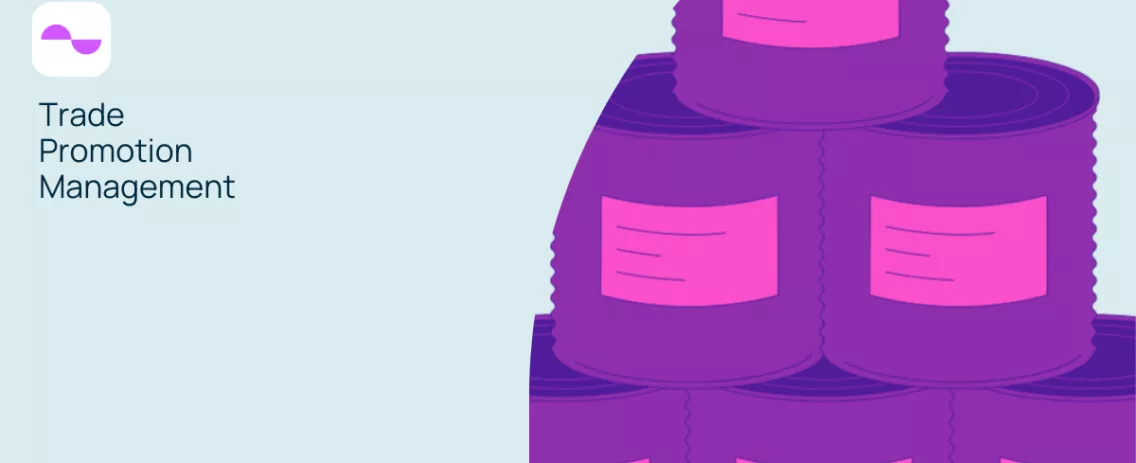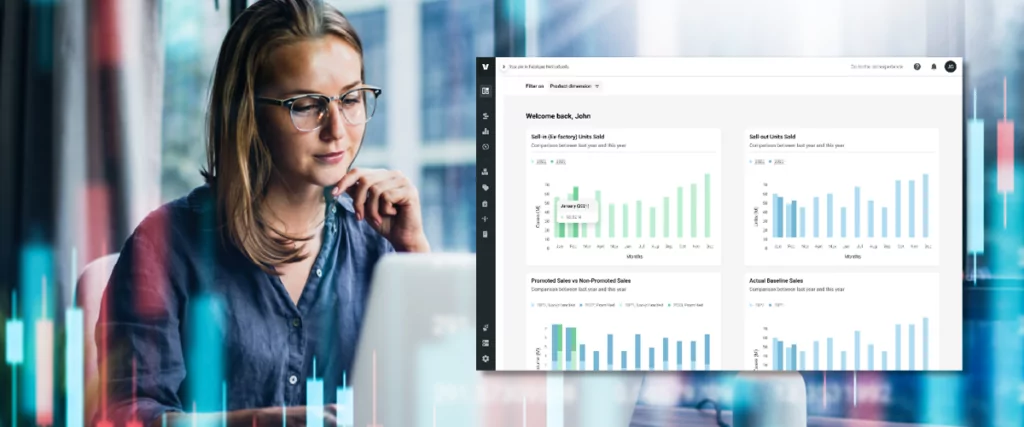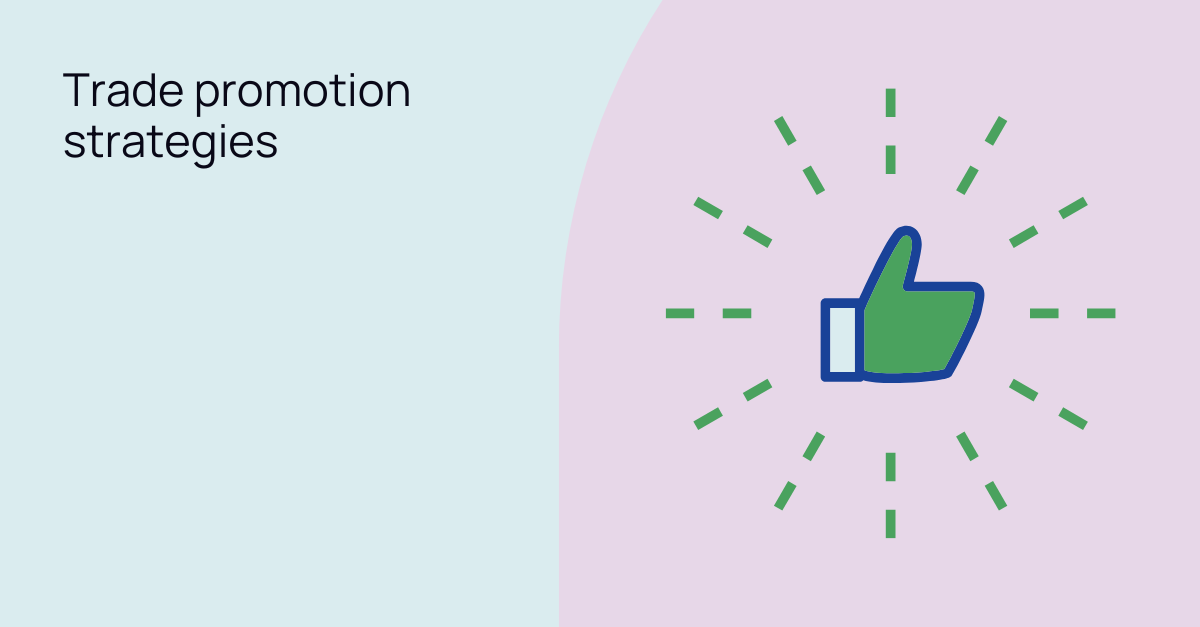
What is Trade Promotion Management and why does it matter?
In today’s fast-paced and competitive business landscape, effective trade promotion management (TPM) is critical for consumer-packaged goods (CPG) companies to stay ahead of the game. However, with the numerous of promotional activities available, it can be challenging to determine which strategies will yield the best results.
In this article, we aim to provide sales and accounts professionals in the CPG industry with a fundamental understanding of trade promotion management. Our goal is to help them improve their promotional campaigns by covering the basics:
- What trade promotion management is
- Ways to get better results from your promotions
- How trade promotion management software works
We’ve put a lot of thought into this article and wrote it in collaboration with experienced CPG professionals. Below, we will start by exploring trade promotion management from its definition all the way to the impact it has on a CPG company’s revenue growth.

So, what is trade promotion management?
We don’t know precisely when an innovative baker first declared their cakes were not just good, but “hot”. But we can guarantee that one of their equally switched-on rivals quickly countered with the promise of a free third cake whenever a customer bought two.
Manufacturers and retailers have always used a myriad of ways to attract customers’ attention and encourage them to buy their products. But today’s consumer goods manufacturers may have tens to tens of thousands of products. A broadline retailer will have thousands, typically tens of thousands of lines.
Just passively tracking all these different SKUs is a challenge, spanning ERP, EPOS, and demand planning systems. Marketing and promoting such an assortment of products means a whole other level of complexity.
But looked at another way, those wide product ranges and disparate systems represent a potential treasure trove of data. Data that, with the right tools, can be used by CPG professionals to develop and optimise innovative trade promotion plans, deliver more reliable forecasts, and generate on-going insights into what is really happening at consumer level. The result is a trade promotion strategy that benefits manufacturers and retailers, and delights customers.
The fundamentals of TPM
CPG manufacturers engage in trade promotions to achieve one of two main aims.
They may want to boost results, such as increasing market share, net revenue, or profit. They might even try to boost two of these metrics at the same time. Boosting all three is usually too much of a stretch.
Alternatively, they will be looking to encourage consumers to try or consider their brand, or to entrench brand loyalty. This might be for the launch of an entirely new product, or a new variant of an existing one.
The marketer’s tool kit spans deals and discounts, such as two-for-one offers, price discounts or after sale rebates, or special bundles.
It can also include activities to grab buyers’ attention, with in-store displays or events, or branding touting a new or improved formulation. All of these may be backed to a greater or lesser degree by advertising and other marketing activities.
Managing all of these requires tools that can support the planning, creation and execution of trade promotion plans.
Key account managers need to draw on current and historical data where appropriate to forecast results of proposed plans and analyze ROI of promotions while they are in progress. And they need to be able to plot workflows, and to share progress and results with colleagues and managers, and partners where appropriate.

The benefits of trade promotion management for CPG companies
As we’ve seen, consumer-packaged goods manufacturers use a broad range of techniques to promote their products, whether the ultimate aim is to boost sales of an existing line or embed a new product in shoppers’ consciousness.
But no promotion happens in a vacuum. As an account manager, you might be responsible for several lines, and each of those might have multiple variants. You may be operating within an organization that might have hundreds or thousands of products.
Just keeping track of all of these—and ensuring that promotions are not running counter to each other—is demanding.
Moreover, you will be working with partners whose objectives might be subtly different to yours. A retailer might be keen to run as many promotions as possible to get customers inside their stores. This might run counter to your wish to promote a given product, without undermining its cachet—or profit margins.
Things to keep in mind
So, when managing a particular set of promotions, there are a number of things you must keep in mind.
You need a clear idea of what you want to achieve both with an individual line, and with your assortment overall, from the outset. So, you will need tooling to help you set aims and develop plans accordingly.
You also need to be able to make well-founded forecasts of the effect each promotion will have. This means having access to centralised ex-factory data as well as previous promotion plans and relevant data.
But that’s just the start. You also need to be able to see the impact of promotions over the period and react accordingly. Likewise, there will inevitably be things outside of you control—supply chain issues, unexpected weather—which can affect consumers’ appetite for or attitude to products.
So, you need a way to incorporate fresh data over the lifecycle of a promotion, adjusting forecasts where appropriate, and showing actual and predicted results.
And you need to be able to do all this in concert with your retail partners. You must ensure they’re supportive of the aims and methods of promotions, and happy with the eventual outcome. The aim, after all, is to achieve a win-win.
Key features of TPM software
In the past, trade promotion management meant navigating between ERP systems and spreadsheets. However, this approach can quickly become cumbersome, particularly if there is no easy way to access historical and up-to-the-minute data. TPM professionals are then forced to cut and copy data from one system to another. This is not only tedious but also likely to lead to mistakes.
This makes it hard to forecast trade promotion effectiveness and monitor their progress. It also makes innovation more difficult. Harried account managers may simply look to repeat previous promotions, with a smattering of updated data.
There are dedicated TPM platforms available, which can bring a degree of automation to the process. The ability to funnel simple selections and get an overview of your promotion planning can offer a big advantage over working with multiple spreadsheets. Again, a key factor here is data integration. Connectivity into the core ERP system is one thing. Being able to take advantage of the full range of data available—including third party or syndicated content—is another.
But really, these are just table stakes.
If your data is marooned in spreadsheets or sitting in siloed, hard-to-update TPM systems, it’s not helping you add value.
Does it help you generate new TPM plans? Does it help you generate more reliable forecasts, while highlighting those selections which are going to require additional attention?
What’s needed is a software solutions that doesn’t just allow you to see your trade promotion plans, but to actively manage and optimize them.
If you can bring automation and integration to bear on the administrative aspects of trade promotion management, you will be freeing yourself up to focus on the trickiest challenges.
Choosing the right TPM solution
So, what does modern TPM software really look like? There are a number of key factors you should consider.
Ease of use:
This is essential. As a TPM professional your expertise lies in your ability to plan and approve your promotions, then optimize and execute them. This is what you should be focusing on, not the management and integration of disparate technology and diverse data sources or the configuration of TPM templates and workflows.
Data integration:
Optimizing your trade promotion management means you need access to all the relevant available data. This starts with ex-factory data, so stress-free integration with your ERP system is a given. But to really optimize your promotions, you need an overview of the market as a whole. This means you will need access to other systems and syndicated data. If your platform can’t easily provide this, you’re flying blind.
Fully configurable:
Each organization is different. As is each product assortment. Your TPM solution should offer you the chance to configure approval workflows and execute plans that fit the way your organization operates, not how a vendor thinks it should work.
And because your trade promotions are happening in real time, your trade promotion management needs to be real time too. Which means automated real-time integration with your ERP and demand planning systems is a must.
Accurate forecasting:
Accurate trade promotion forecasting is key both to planning your promotions and assessing their performance and ROI over time. Again, this relies on the ability to integrate ex-factory and syndicated data. But you also need to be able to trust your system’s forecasting abilities, whether that’s traditional analytics or, when you’re ready to make the leap, the ability to use cutting-edge AI.
Code switching and product lifecycle:
Product assortments go through numerous hard and soft changes over the course of their lifecycle. Each change—such as a new recipe sticker or a packaging change—can mean a code switch in your system. These soft switches have implications for trade promotion management. There is the administrative overhead of including the “new” product in existing promotions. They can make it hard to track progress over the course of a promotion and to assess a campaign’s total impact. The ability to easily accommodate code switches can dramatically improve your visibility into the progress and success of your promotions.
The latest and greatest codebase:
You want to focus on optimizing your trade promotion management, not on managing and configuring your software. Highly customizable systems may seem tempting. But in practice they can mean lengthy and expensive consultancy engagements before you even start managing and optimizing your promotions. A software-as-a-service TPM system means you can get to work straight away. And you can take full advantage of new functionality, including cutting-edge AI features, as they are deployed.
Visualfabriq’s Trade Promotion Master solution

Visualfabriq’s Trade Promotion Master has been built to enable you to plan and optimize your trade promotion strategy, easily and continuously, from initial planning to end-of-promotion analysis.
It allows you to use all available data sources, including ex-factory, EPOS and syndicated, removing the overhead of manual or semi-automated updates.
This allows you to generate reliable forecasts from the outset and gain real-time insights over the lifecycle of your promotions.
The forecasts are powered by Visualfabriq’s AI technology, which predicts the ROI and performance of promotions, whatever your ultimate aims are.
This is all available to you via a single screen, so that insights can easily be shared with partners, you are never blindsided by questions from colleagues, and meetings are more productive.
And because Trade Promotion Master is a true software-as-a-service application, you are always working with the most up-to-date features, with no need for upgrade downtime.
Conclusion
Trade promotion optimization delivers the right data and the right insights so you can make the right decisions. You can then spend more time focusing your expertise on the outliers or most pressing cases, and spend less time on administrative tasks.
With the relevant information at your fingertips, justifying your programs to your colleagues and managers becomes much easier. This all adds up to promotions that are more likely to succeed, whether the aim is building revenue, increasing profits, or boosting market share.
It also gives you more time and more insight to share with your retail partners. So, you can build a deeper relationship, based on mutual understanding, and develop more innovative, win-win promotions.
That’s why having the right TPM software doesn’t just help you optimize your trade promotions. It will help you improve your business overall.
If you want to truly unlock the power of your trade promotions with Visualfabriq Trade Promotion Master, download our brochure and book a demo now.

.png)

